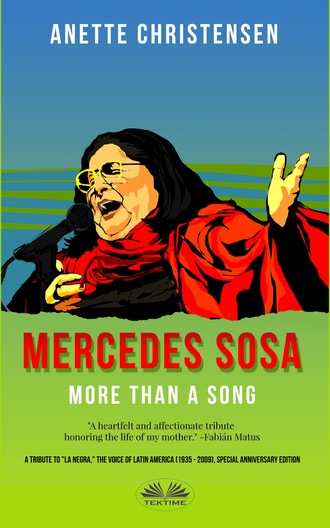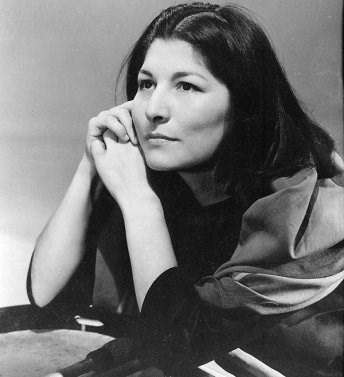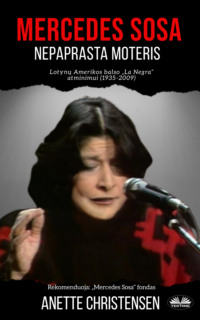
Полная версия
Mercedes Sosa – More Than A Song

Anette Christensen
Mercedes Sosa – More than a Song
Endorsements
“In this work, you will find a new and touching perspective on our beloved Mercedes. It is a heartfelt and affectionate tribute honoring the life of my mother. Thank you, Anette, for all your efforts in the name of the Mercedes Sosa Foundation.”
-Fabián Matus, son of Mercedes Sosa and president of The Mercedes Sosa Foundation.
Tribute
“If Mercedes had embraced you, you’d never forget it. She had the ability to embrace people like no one else in the world; one always had the feeling of being embraced by Mother Earth herself. She took all of us in her arms with her voice, with this unequaled bel canto voice, which was always a pure expression of her soul. There was never anything artificial about this wonderful woman, this brave woman, this icon of courageous resistance to military dictatorship. For me, she radiated the most important thing that makes a great human being: kindness."
-Konstantin Wecker, singer and poet, Germany

No part of this book may be reproduced in any written, electronic, recording, or photocopying without written permission of the publisher or author. The exception would be in the case of brief quotations embodied in the critical articles or reviews and pages where permission is specifically granted by the publisher or author. Although every precaution has been taken to verify the accuracy of the information contained herein, the author and publisher assume no responsibility for any errors or omissions. No liability is assumed for damages that may result from the use of information contained within.
Publisher: Tribute2Life Publishing
Editors: NY Book Editors & David Larkin
Cover Design: © Tribute2Life Design
Cover Photo: © Ernesto Guerrero Pititore
Back Page Cover Photo: © Reuters
Interior Design: © Tribute2Life Design
Interior Drawings © Anette Christensen
Chapter Opening Illustrations: © by Monica Gaifem
Author Photograph: © Pernille Schmidt
Set with: Lora Font & Antonio Font
First Editions
Mercedes Sosa-More than a Song by Anette Christensen
© 2019 by Anette Christensen. All rights reserved.
Dedication
In honor of Fabián Matus, Mercedes Sosa’s son, who passed away on March 15, 2019, less than ten years after his mother. You worked wholeheartedly for your mother when she was alive and maybe even harder to establish her legacy after her death.
To the Grandmothers of the Plaza de Mayo, who in a high age, are still active in their search of the children stolen from their parents and given to the Generals during The Dirty War. You are an example to all of us, that age is no hindrance to making a change in this world.
To people Mercedes Sosa loved and served her entire life. Those who suffer under the burden of poverty, persecution, censorship, torture and social injustice in any form, the indigenous, the disenfranchised, the oppressed, the homeless, the orphans, the depressed, the lonely, and everyone who has never been seen and loved for who they are.
Introduction
ON OCTOBER 4, 2009, when her death was announced on the news, I caught my first glimpse of Mercedes Sosa. There was a very short sequence of her singing “Gracias a la vida” at an acoustic concert in Switzerland in 1980. The first thing that struck me was her authenticity. I could sense that she was a person of tremendous integrity. What she expressed seemed to be in complete accordance with who she was. The intensity and firmness in her voice, the intoning of every note and every word reached me like glassy water reflecting my soul. Her tenderness, profound passion, immense presence, and charisma moved me deeply. I started to watch and listen to Mercedes Sosa on the internet and soon I found myself completely immersed in her life,– a universe of music and love. Tears would run down my cheeks as I watched her and listened to her songs and intuitively, I began to use her eyes like a mirror that reflected back to me what I had missed out on as a child. In her eyes I saw the glance of a mother, a glance that said, “I see who you are, and in my eyes you are wonderful.”
Since my discovery of Mercedes Sosa had such a deep and haunting impact on me, I began searching for any bit of information I could find about her. I soon learned that I wasn’t alone with the experience of being invigorated and transformed in her presence. As I delved deep into Mercedes’ life I discovered that her fans often referred to her as a “mystical presence.” This aroused my curiosity to gain a better understanding of her personal life—her relationships with her family, fans, and friends as well as the events that shaped her life on a personal and professional level. I embarked on a quest to find the secret behind her enormous impact and this so-called “mystical presence.”
What I discovered affected me on various levels. Watching how Mercedes dealt with social and political problems increased my social awareness. Witnessing how she related to others, whether it was peasants or presidents, friends or foes, touched me deeply and aroused a desire in me to become more respectful and compassionate and to pay full attention to others.
I am a sensitive and intuitive person who always looks for the best in others. Sometimes when I meet a person for the first time, my inner detector tells me that I have struck gold. It is a sensitivity that makes me feel a person’s essence and see their innate beauty immediately. It is exactly what happened when Mercedes Sosa came up on my radar. I felt I had found a treasure, and the more I got to know about her, the more convinced I became, that I had encountered a legend.
Naturally, I was interested in talking to others about her, so I kept asking everyone on my way if they had heard of her, but I never had a positive answer. Realizing that she was still an unsung hero in the English speaking world, as well as my longing to get to know her, learn from her and connect with her gave me inspiration to write this book. I remember sitting on the stairs outside our house looking up at the stars when the thought crossed my mind for the first time only one month after her death.
Writing this book has been like putting a jigsaw puzzle with one thousand pieces together, starting with having only one single piece and no idea what the full picture would look like. I was so attracted to the single piece I had found, that I had to search for the nine hundred and ninety other pieces. I am a go-getter and extremely persistent, and the challenge of not having access to the Spanish sources only increased my motivation. The first four years were a lonely journey as I didn’t have anyone I could share my passion with, but it changed in 2013, a year after my husband and I had moved from Denmark to Turkey.
I was on my way back from the beach when I passed by a small shop which I passed by every day. This particular day I spotted a beautiful turquoise batik dress that was hanging outside. Turquoise being my favorite color at the time, I decided to stop and try it on. Up to that time we had met only two English-speaking Turkish people, so when the lady in the shop approached me and I realized she spoke English quite well, I was surprised and overjoyed.
I was a little stunned too because she looked almost exactly like Mercedes Sosa at a young age. She was a small exotic-looking woman with long black hair and intense dark eyes. Furthermore, I immediately recognized that her essence was similar to Mercedes Sosa’s. Naturally I couldn’t help but ask her the same question I had asked everybody on my way the past four years, though I never got an affirmative answer. I asked, “Do you know Mercedes Sosa?”
Her answer made my heart jump. “Of course I know her. I love her!”
When I told her I was writing a book about Mercedes Sosa, she got excited and said she wanted to read it and even sell it in her shop. She also told me she had been working in the book industry in Turkey most of her life and was keen on translating the book into Turkish. I wasn’t finished when we met, but meeting her encouraged me to do so and get it published. It became the beginning of a very special friendship, and I believe it was life’s way to encourage me to move on with the project.
While writing this book, I reached out to Sosa’s family in Argentina in hopes of receiving some insights into her life as well as to receive their blessing on this project of documenting her life, upbringing, career in music, and the social and political environment she lived in. I am very happy that they approved of the book at a very early stage and found my psychological approach enticing.
I also engaged with some of Mercedes Sosa’s personal friends and fans and have included their stories as well. Through my connection with the Latin American people on Facebook, where I now have over 16,000 followers, I began to understand Mercedes Sosa’s deep affection towards her people. The Latin American people have become very special to me too and their love, support and encouragement has touched my heart.
I do not consider this book to be a complete biography of Mercedes Sosa—rather it is a personal profile of her. I have used my imagination in a few places to fill in some of the gaps without reducing the credibility of the overall story. These passages are listed in the addendum. Here I also explain how I used a mindful approach to get to know Mercedes well enough to write this book without having access to the Spanish sources.
Maybe you wonder why I’m making the effort to describe the political situation in South America. Through Mercedes, I developed an affection for South America and realized that the continent is much overlooked in the media outside the Spanish-speaking world. As Mercedes Sosa’s friend, the Cuban singer Pablo Milanés once said, it is not possible to tell the story of Latin America without mentioning Mercedes Sosa. I believe the opposite is true as well. It is not possible to tell about Mercedes Sosa without telling about this troubled but vibrant continent in which Mercedes invested her entire life. I refer to South America as the continent in the western hemisphere consisting of the countries and islands south of Panama. I use Latin America as a cultural entity of Spanish and Portuguese speaking nations in both Americas.
On my YouTube Channel, Mercedes Sosa – The Voice of Hope, you will find a playlist with many of the songs and episodes that I describe in the book. As you come across these songs, I encourage you to visit the channel so that you may fully appreciate what is being described.
I am excited that after almost ten years of pondering, listening, watching, researching, and writing, I can finally introduce you to this amazing woman who influenced an entire continent by using her unique talent and outstanding personality. and who turned my life around even after her death.
If you want to know more about my personal journey with Mercedes Sosa, it is included in Mercedes Sosa – The Voice of Hope, where I show you how I recovered from emotional wounds by relating to Mercedes Sosa as a mother. I believe my story as well as the scientific insights that back up my experience can be useful to anyone who finds him or herself stuck in limiting, crippling, or tormenting experiences from the past. This edition is published to mark the 10th anniversary of Mercedes Sosa’s death and contains only the biographical part of the original book.
I have written this book out of deep respect for Mercedes Sosa and everything she stands for. This is my love song to Mercedes Sosa. In her voice, life becomes a song with a scent of hope as sweet and beautiful as the flower that grows in the paths of those who looks forward. Her voice represents a woman who in turn represents dreams, ideals and love that go far beyond the border of music. Mercedes Sosa was more than song. She was the voice of hope to many. May this book extend her voice and the hope she kindled.
“The most beautiful people we have known are those who have known defeat, known suffering, known struggle, known loss, and have found their way out of the depths. These persons have an appreciation, sensitivity and an understanding of life that fills them with compassion, gentleness, and a deep loving concern. Beautiful people do not just happen.”
Elisabeth Kübler-Ross

Denmark, October 4, 2009
“The Argentine singer and folk heroine Mercedes Sosa has died from multiple organ failure at a hospital in Buenos Aires after being admitted three weeks ago. Her career spanned over six decades and she recorded more than forty albums, performing all over the world. Sosa was the underground reference point for many Argentines during the time of dictatorship, and through her songs she gave life to the protest movement among the working class, a movement which led to the collapse of the military junta in 1983. Mercedes Sosa became famous in Europe when she was living in exile in Spain and France from 1979 to 1982. She lived to seventy-four years old.”
IT’S A SUNDAY evening and I settle to watch the news with my husband. Along with a report of Mercedes Sosa’s death, a short film clip of a beautiful lady with long, dark hair, wearing a black dress with a red Andean poncho on top comes up on the TV screen. With extraordinary passion and a voice remarkable and soulful, she sings a song, “Gracias a la Vida” (Thanks to Life). I become captivated by her authenticity and charisma, and it takes only but a short while to realize I am watching a genuine and sincere woman so pure and extraordinary that I begin to wonder why I haven’t heard of her before now. As if nothing else matters, I get up to use the internet and find out more about this lady. An enormous number of YouTube links come up. I begin to watch and listen.
In the first clip, Mercedes sings “Zamba por vos” (Zamba for You) ever so gloriously with the Argentine folklore quartet, Los Chalchaleros. Radiant and graceful as a gentle embrace Mercedes arrives onstage with a consolatory smile on her lips and a sparkle of vitality in her eyes. To unending applause she proceeds to greet the members of the group, drawing them into warm embraces. Then she turns to the crowd and with a calm demeanor, starts singing in her contralto voice—deep, pleasant, and soft.
The second clip I watch is “Todo cambia” (Everything Changes), recorded at the Festival de Viña in Chile, 1993. Dressed in black from top to toe, she appears mystical and monumental, sounding just as powerful and convincing as she looks. I sense a tremendous energy emanating from her as she conquers the stage with her Latin American dancing steps and her scarf swinging above her head. I see a dynamic and forthright person who is unafraid of expressing her true self. The sincere and tender yet firm look in her eyes captivates me, and I feel as though she is looking directly into my soul through the computer screen. There is something about her, a “mystical presence,” which reaches to the deepest parts of my being, and my well of longing. Tears stream down my face as I realize I have encountered something that I have always hoped to find.
I instinctively know that she is a singer with a message and a mission. I want to find out what they are.
Buenos Aires, October 4, 2009
FOLLOWING THE President’s official announcement marking the start of three national days of mourning, the flags are flown at half-mast all over Argentina. Across the country concerts and shows scheduled during this period are cancelled, and condolences from heads of state—in Latin America and the rest of the world—pour in.
“La Negra” (The Black One), as she was fondly called owing to her jet black hair and her Northern Argentine, Andean ancestry, lies peacefully in her casket in the most formal room of the Congress, the “Salón de los Pasos Perdidos,” an honor reserved for only the most prominent of national icons. On Avenida Callao, the street leading to the Congress, admirers line up to pay their respects.1
In the Pasos Perdidos, lavish wreaths adorn the impressive marble hall. Gigantic chandeliers and massive candles light up the dimness of the high-ceilinged room with the uncovered casket positioned right in the center. Argentina’s president, Cristina Fernández de Kirchner, accompanies Sosa’s family as they pay homage to the singer. The family, including Mercedes’ son, Fabián Matus, and her two grandchildren, Agustín and Araceli, stand closely with their arms around each other as though in a half-embrace while Cristina caresses Mercedes Sosa’s lifeless hand. Christina’s husband, the former President Néstor Kirchner, stands rather guardedly by her side with a cautious look.
Ordinary people are there too. Respectfully, a growing flock of mourners pass by the open casket where she is seen resting in her embroidered blue dress. Her long, black hair, which at the age of seventy-four, doesn’t have a single strand of gray in it, frames her calm, high-cheekbone face. Her hands are carefully folded on her stomach around a bouquet of white roses. Singer Argentino Luna plays her songs as weeping fans sing along and take turns to leave flowers by her coffin.

October 5, 2009
FABIÁN AND Mercedes’ closest relatives follow the brown wooden casket as it is carried out to the hearse parked outside the Congress. All along Avenida Rivadavia, crowds of mourners, of all ages, gather to watch the hearse take her on her last journey, from the Congress to the crematorium. They stand united in a moment of Argentine history that dissolves social and political boundaries.
The procession of hearses drives past slowly and a number of mourners carry banners that say adorable things about her. An old revolutionary in his sixties is holding up a banner that reads, “Thank you for your life and your struggle.” A number of people can be seen clapping and waving the Argentine flag with graceful enthusiasm. The young make happy noises, chanting, “Olé Olé Olé Olé, Negra Negra,” in repeated fashion as though it were the national soccer team returning after winning a championship. At virtually every corner, groups of people bearing different instruments start to sing. Beautiful music echoes through the streets of Buenos Aires—music that has provided hope and comfort for decades, challenging tyranny and fostering democracy.
It is a day of sorrow that reaches deep into the Argentine soul. The national folk heroine, the mother of the nation, is dead. But what she gave through her life and her songs will never die. They live on.
The procession slowly leaves the Congress. The first hearses carry all the flower decorations. The last carries the casket.

Time before Exile
San Miguel, Tucumán, July 9, 1935
AT SANTILLÁN HOSPITAL, in northwest Argentina, twenty-four-year-old Ema del Carmen Girón has just given birth. It is seven o’clock in the morning. Her newborn daughter is safely asleep in her arms. The baby announced her entrance into the world with a hefty squall that could be heard all over the maternity ward. What no one knows is that one of history’s best voices has just made its first sound. Ema is grateful for this new and precious life she is holding in her arms, and, for a while, she forgets all the financial challenges that will come with raising a child. Ema has a job as a laundress, and her husband, Ernesto Quiterio Sosa, works in the sugar industry harvesting sugarcane and shoveling coal into the oven at the Tucumán Mill.
Through the half-open window, Ema can hear cannon salutes in the distance. She counts them—twenty-one. July 9 is Argentine Independence Day. Ema’s instinct is that it is not a coincidence that her daughter is born on this day. She confides in the midwife, who has just come back to the room, “This girl is going to be someone with great influence one day. Her birth is being welcomed by twenty-one salutes.”2 She keeps this conviction in her heart from this moment on.

EMA AND her husband, Ernesto, usually agree on everything, but when they have to give their newborn daughter a name, they run into some trouble. Ema wants to call her Marta, while Ernesto opts for Mercedes, after his mother, and Haydeé, after a well-liked cousin. Ultimately she gets the name Haydeé Mercedes Sosa, but for the rest of her life her mother will stubbornly call her Marta.3
Mercedes grows up in Tucumán, which is also called the Garden of the Republic. A semi-tropical and agricultural region with countless fields of sugarcane, flowers, and fruit trees, the smallest province in Argentina. It is in this oasis in the northwest corner of Argentina that Mercedes grows up with her older sister, Clara Rosa—also called Cocha—and her two brothers, Fernando and Orlando. The family resides in a poor, working-class area. The pink paint on the outer walls of their small, one-story house at Calle San Roque 344 is becoming black from the soot and smoke of the nearby factories, and in some places the paint is chipping off. The only light that gets into the house comes through two small windows with iron bars that face a narrow street where the children used to play, inventing their own games because they never had toys. Fortunately, they live close to the local park, which also has its ties to the date of Argentine independence, being named Parque de 9 Julio. It becomes a second home to them.
Growing up, Mercedes enjoys playing in the park with her siblings and the other children in their modest neighbourhood.4 She is always cheerful and connects with others easily. But sometimes she prefers to be on her own and withdraws to her favorite tree. She likes to sit leaning against the bark while watching the insects buzzing around her. She is a robust child in many ways, but she also has a sensitive, reflective side that makes her wonder why some people are rich while others are poor. Very early in her life, she has a developed feeling for right and wrong. It is a sensibility caused directly by seeing her parents work so hard to keep hunger from their doorstep. Even doing their utmost, they often can’t afford to buy food for their children. To distract their children from their hunger, they take them to the park to play every evening at dinnertime.3 To Mercedes, Saturdays are the best days because that’s when her father gets paid and the family can enjoy a meal of spaghetti with butter, the only hot meal they get all week. Often the hunger keeps her awake for hours at night.4
Still, later in life, Mercedes would come to say she had a happy childhood. “I do not wish to wail like someone who has lived in hunger, poverty, and cold. I lived my childhood in a poor house, which was however warmed up by the necessary feelings. My siblings and I always had the essentials, because we never lacked love. In this respect we were millionaires. Our parents not only sacrificed their lives, but they have been wise. They never put a burden on us for their sacrifices. They gave us everything they could, without revealing to us what they had to do to achieve this.”5
Mercedes never truly grows out of the mindset of poverty she grew up with, and it shapes her social consciousness and gives her sympathy for the poor, which, along with the love of her parents, shapes her ideology and provides the firm foundation on which she will continue to stand. As an adult she concludes, “Poverty has always chased us, but it never broke us down. It only helped us to be free and choose our way of thinking.”3








